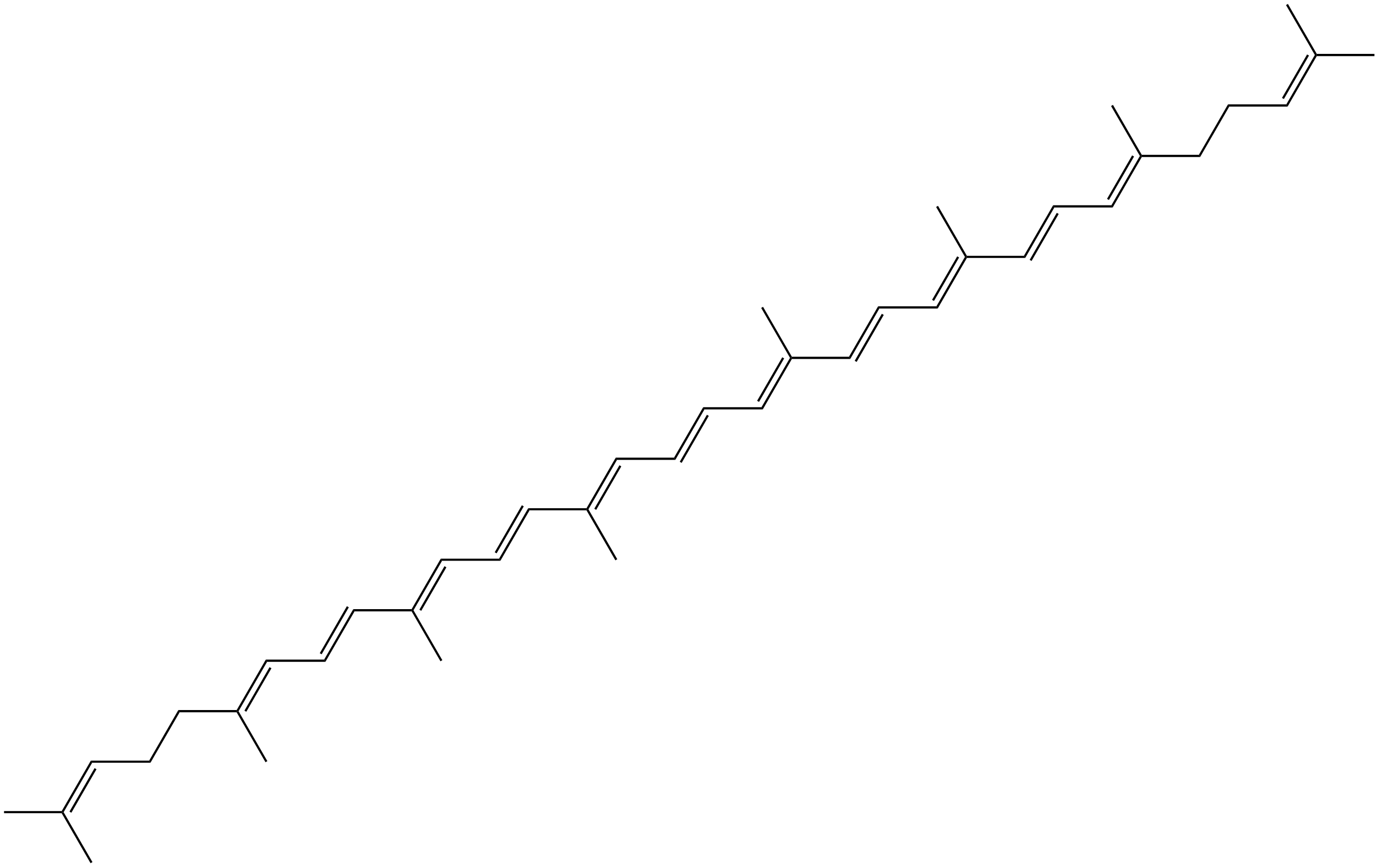Lycopene (Synonyms: NSC 407322) |
| Catalog No.GN10448 |
Products are for research use only. Not for human use. We do not sell to patients.

Cas No.: 502-65-8
Sample solution is provided at 25 µL, 10mM.
GlpBio Products Cited In Reputable Papers
Product Documents
Quality Control & SDS
- View current batch:
- Purity: >98.00%
- COA (Certificate Of Analysis)
- SDS (Safety Data Sheet)
- Datasheet
- Purity: >98.00%
- COA (Certificate Of Analysis)
- SDS (Safety Data Sheet)
- Datasheet
- Purity: >95.00%
- COA (Certificate Of Analysis)
- SDS (Safety Data Sheet)
- Datasheet
- Purity: >90.00%
- COA (Certificate Of Analysis)
- SDS (Safety Data Sheet)
- Datasheet
| Cas No. | 502-65-8 | SDF | |
| Synonyms | NSC 407322 | ||
| Chemical Name | (6E,8E,10E,12E,14E,16E,18E,20E,22E,24E,26E)-2,6,10,14,19,23,27,31-octamethyldotriaconta-2,6,8,10,12,14,16,18,20,22,24,26,30-tridecaene | ||
| Canonical SMILES | CC(=CCCC(=CC=CC(=CC=CC(=CC=CC=C(C)C=CC=C(C)C=CC=C(C)CCC=C(C)C)C)C)C)C | ||
| Formula | C40H56 | M.Wt | 536.89 |
| Solubility | <3.03 mg/mL in 0.5MNAOH | Storage | Store at -20°C, protect from light, stored under nitrogen |
| General tips | Please select the appropriate solvent to prepare the stock solution according to the
solubility of the product in different solvents; once the solution is prepared, please store it in
separate packages to avoid product failure caused by repeated freezing and thawing.Storage method
and period of the stock solution: When stored at -80°C, please use it within 6 months; when stored
at -20°C, please use it within 1 month. To increase solubility, heat the tube to 37°C and then oscillate in an ultrasonic bath for some time. |
||
| Shipping Condition | Evaluation sample solution: shipped with blue ice. All other sizes available: with RT, or with Blue Ice upon request. | ||
Complete Stock Solution Preparation Table
| Prepare stock solution | |||

|
1 mg | 5 mg | 10 mg |
| 1 mM | 1.8626 mL | 9.3129 mL | 18.6258 mL |
| 5 mM | 0.3725 mL | 1.8626 mL | 3.7252 mL |
| 10 mM | 0.1863 mL | 0.9313 mL | 1.8626 mL |
In vivo Formulation Calculator (Clear solution)
Step 1: Enter information below (Recommended: An additional animal making an allowance for loss during the experiment)
 g
g
 μL
μL

Step 2: Enter the in vivo formulation (This is only the calculator, not formulation. Please contact us first if there is no in vivo formulation at the solubility Section.)
Calculation results:
Working concentration: mg/ml;
Method for preparing DMSO master liquid: mg drug pre-dissolved in μL DMSO ( Master liquid concentration mg/mL, Please contact us first if the concentration exceeds the DMSO solubility of the batch of drug. )
Method for preparing in vivo formulation: Take μL DMSO master liquid, next addμL PEG300, mix and clarify, next addμL Tween 80, mix and clarify, next add μL ddH2O, mix and clarify.
Method for preparing in vivo formulation: Take μL DMSO master liquid, next add μL Corn oil, mix and clarify.
Note: 1. Please make sure the liquid is clear before adding the next solvent.
2. Be sure to add the solvent(s) in order. You must ensure that the solution obtained, in the previous addition, is a clear solution before proceeding to add the next solvent. Physical methods such as vortex, ultrasound or hot water bath can be used to aid dissolving.
3. All of the above co-solvents are available for purchase on the GlpBio website.
Related Products
- GC31316 H-Phe-Phe-OH
- GC33456 Gadopentetate dimeglumine (SH-L-451A)
- GC35075 20-HETE
- GC30223 Gly-Arg-Gly-Asp-Ser
- GC45981 Pristanic Acid-d3
- GC12290 Norgestimate
- GC60540 8-Aminooctanoic acid
- GC40783 5(Z),8(Z),11(Z)-Eicosatrienoic Acid
- GC19271 ONO-8590580
- GC30868 Cinromide (trans-3-Bromo-N-ethylcinnamamide)
- GC43915 Isokotanin B
- GC18872 Propargylcholine (bromide)
- GC31838 Losmiprofen
- GC40641 5'-Ethynyl-2'-deoxycytidine
- GC47142 Cycloguanil-d6 (hydrochloride)
- GC17377 Clofibrate
- GC35716 c-Met inhibitor 1
Reviews
Average Rating: 5 ★★★★★ (Based on Reviews and 30 reference(s) in Google Scholar.)
GLPBIO products are for RESEARCH USE ONLY. Please make sure your review or question is research based.
Required fields are marked with *


















